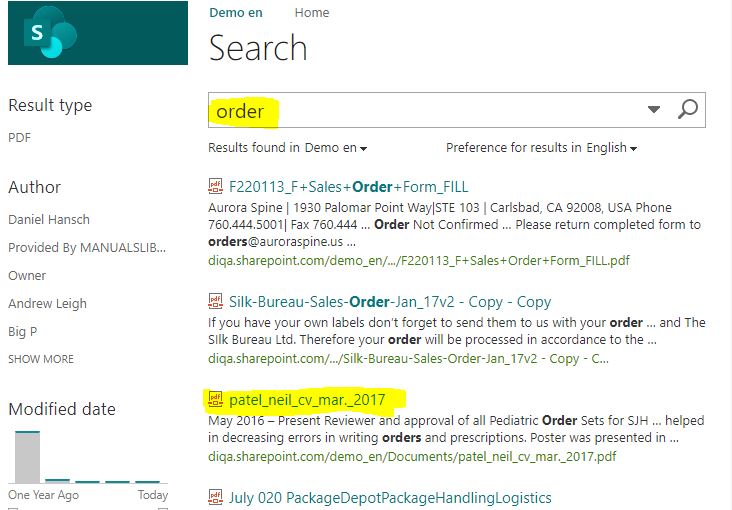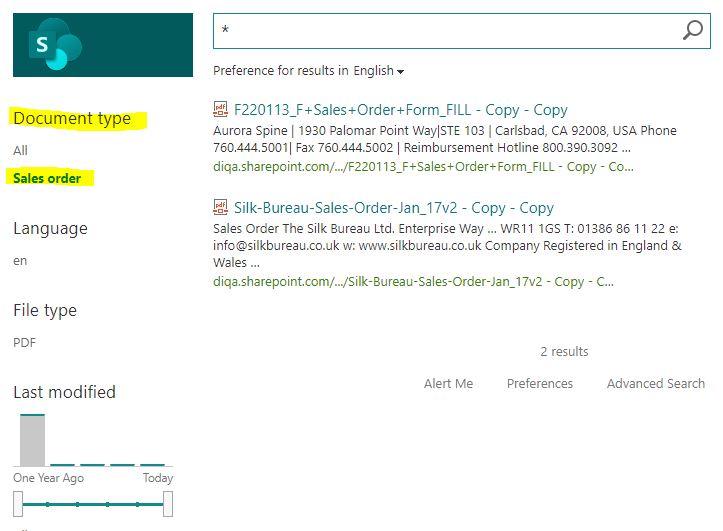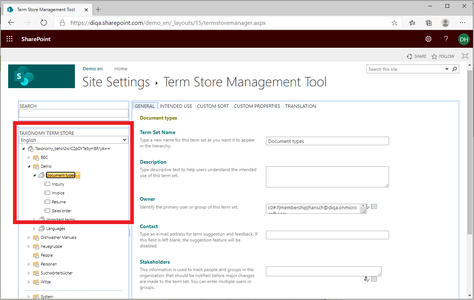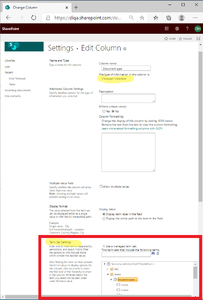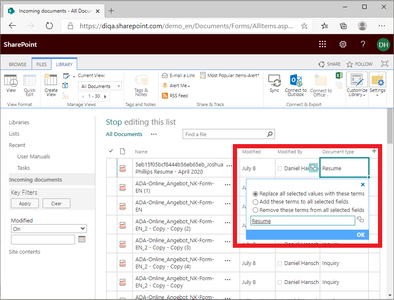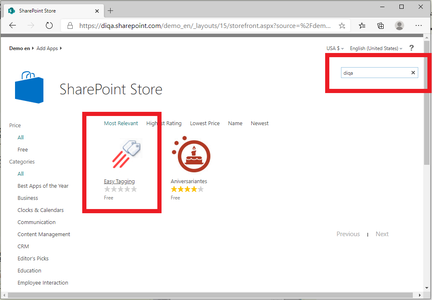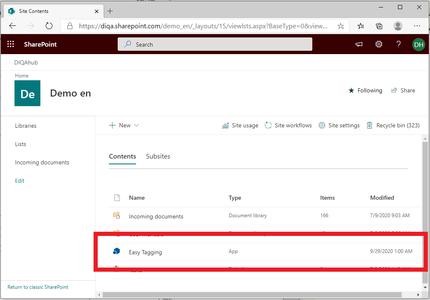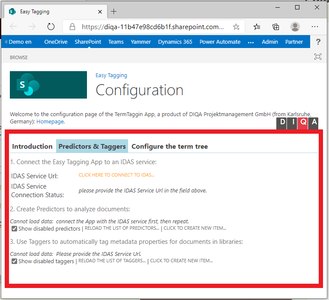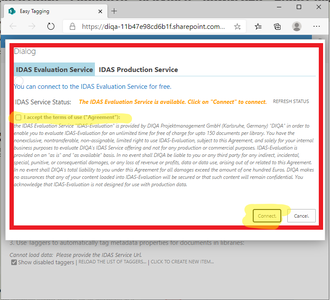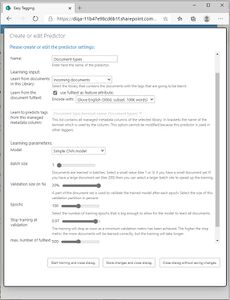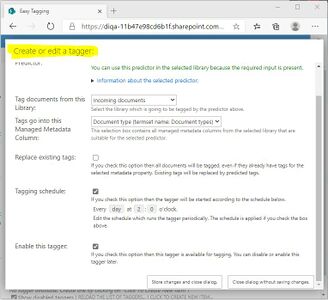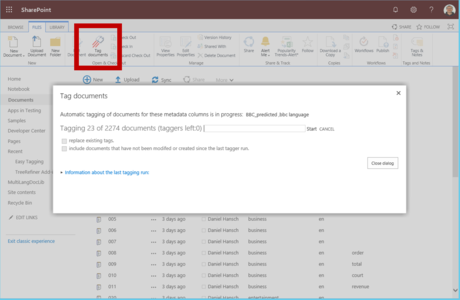Difference between revisions of "Blog/Boost document findability with tags in O365"
| Line 44: | Line 44: | ||
</div> | </div> | ||
<div id="accordion" width="100%" style="display: none; min-height: 300px;"> | <div id="accordion" width="100%" style="display: none; min-height: 300px;"> | ||
| − | <h2> | + | <h2>Step 1: Prepare your library:</h2> |
<div> | <div> | ||
<p> | <p> | ||
| Line 80: | Line 80: | ||
</p> | </p> | ||
</div> | </div> | ||
| − | <h2> | + | <h2>Step 2: Automatically tag all your documents</div> |
| + | <div> | ||
| + | <p> | ||
| + | <div class="row funktionen-row">Install the Easy Tagging App (free!) from the Sharepoint Store/App Source and train a predictor:</h2> | ||
<div> | <div> | ||
<p> | <p> | ||
<div class="row funktionen-row"> | <div class="row funktionen-row"> | ||
<!-- --><div class="col-md-6 col-md-border funktionen" style="text-align: justify; "> | <!-- --><div class="col-md-6 col-md-border funktionen" style="text-align: justify; "> | ||
| − | === | + | === 1. Install the Easy Tagging App from the App Source (free evaluation!) === |
# Open the site settings and click on "Add an App" | # Open the site settings and click on "Add an App" | ||
# Click on "Sharepoint Store" | # Click on "Sharepoint Store" | ||
| Line 95: | Line 98: | ||
<div class="row funktionen-row"> | <div class="row funktionen-row"> | ||
<!-- --><div class="col-md-6 col-md-border funktionen" style="text-align: justify; "> | <!-- --><div class="col-md-6 col-md-border funktionen" style="text-align: justify; "> | ||
| − | === | + | === 2. Launch the app and grant it the requested permissions === |
# Open the site contents again where you should find the newly installed Easy Tagging App | # Open the site contents again where you should find the newly installed Easy Tagging App | ||
# Click on the App and grant it the requested permissions. | # Click on the App and grant it the requested permissions. | ||
| Line 104: | Line 107: | ||
<div class="row funktionen-row"> | <div class="row funktionen-row"> | ||
<!-- --><div class="col-md-6 col-md-border funktionen" style="text-align: justify; "> | <!-- --><div class="col-md-6 col-md-border funktionen" style="text-align: justify; "> | ||
| − | === | + | === 3. Connect the Easy Tagging App with the IDAS service (1/2) === |
# In the configuration page of the Easy Tagging App: click on the "Predictors & Taggers" tab | # In the configuration page of the Easy Tagging App: click on the "Predictors & Taggers" tab | ||
# Click on the link "Click here to connect to IDAS" | # Click on the link "Click here to connect to IDAS" | ||
| Line 113: | Line 116: | ||
<div class="row funktionen-row"> | <div class="row funktionen-row"> | ||
<!-- --><div class="col-md-6 col-md-border funktionen" style="text-align: justify; "> | <!-- --><div class="col-md-6 col-md-border funktionen" style="text-align: justify; "> | ||
| − | === | + | === 4. Connect the Easy Tagging App with the IDAS service (2/2) === |
# In the connection dialog: select the "IDAS Evaluation Service" tab | # In the connection dialog: select the "IDAS Evaluation Service" tab | ||
# Click on "I accept the terms of use" tick box | # Click on "I accept the terms of use" tick box | ||
| Line 123: | Line 126: | ||
<div class="row funktionen-row"> | <div class="row funktionen-row"> | ||
<!-- --><div class="col-md-6 col-md-border funktionen" style="text-align: justify; "> | <!-- --><div class="col-md-6 col-md-border funktionen" style="text-align: justify; "> | ||
| − | === | + | === 5. Create a "Learn Tags" perdictor and let it learn from your examples === |
# After you have created a connection to the IDAS Evaluation service you can setup a predictor which learns to tag documents from your examples. | # After you have created a connection to the IDAS Evaluation service you can setup a predictor which learns to tag documents from your examples. | ||
# In the (now empty) list of predictors click on the link: "Click to create new item". | # In the (now empty) list of predictors click on the link: "Click to create new item". | ||
| Line 141: | Line 144: | ||
<div class="row funktionen-row"> | <div class="row funktionen-row"> | ||
<!-- --><div class="col-md-6 col-md-border funktionen" style="text-align: justify; "> | <!-- --><div class="col-md-6 col-md-border funktionen" style="text-align: justify; "> | ||
| − | === Create a tagger that automatically creates tags for all documents (and future documents) === | + | === 6. Create a tagger that automatically creates tags for all documents (and future documents) === |
# As soon as the training of the predictor has completed, you can enable the predictor by clicking on the "enable" action link | # As soon as the training of the predictor has completed, you can enable the predictor by clicking on the "enable" action link | ||
# Click on "OK" in the prompt that asks you if you want to create a tagger. | # Click on "OK" in the prompt that asks you if you want to create a tagger. | ||
| Line 158: | Line 161: | ||
<!-- --><div class="col-md-6 col-md-border funktionen imageExpand" style="text-align: justify; >[[File:Tag_a_library.PNG|x300px|center|middle]]</div> | <!-- --><div class="col-md-6 col-md-border funktionen imageExpand" style="text-align: justify; >[[File:Tag_a_library.PNG|x300px|center|middle]]</div> | ||
</div> | </div> | ||
| + | </p> | ||
| + | </div> | ||
| + | <h2>Step 3: Create a search center that includes the search refiners</h2> | ||
| + | <div> | ||
| + | <p> | ||
<div class="row funktionen-row"> | <div class="row funktionen-row"> | ||
<!-- --><div class="col-md-6 col-md-border funktionen" style="text-align: justify; "> | <!-- --><div class="col-md-6 col-md-border funktionen" style="text-align: justify; "> | ||
Revision as of 16:14, 29 September 2020
O365: Boost document findability with tags (September 1, 2020)
Finding documents in Sharepoint online/Office 365 can be tedious. If you want to restrict your search to certain document types (like: reports, inquiries, CVs, sales orders, invoices) you either end up with too many irrelevant search hits or relevant documents don't show up because they don't include the search term. If you rely on Sharepoint's fulltext search capabilities only, then your users will be frustrated and spend too much time to find the right documents.
You can provide your users with a better search experience if you use search refiners. Users can further refine their search result by clicking on the refiner values, e.g. to retrieve "sales orders" or "invoices", only. Before you are able to create meaningful search refiners, you have to arrange for a couple of pre-requisites which include tagging documents with tags. This guide shows you how to automatically tag documents with their type (e.g. invoice, sales order, cv, inquiry) and how to provide search refiners that contain these document types.
Frustrating search experience without meaningful refiners:
Entering the search term "order" returns a lot of irrelevant documents (e.g. a CV) and even misses some sales order documents.
